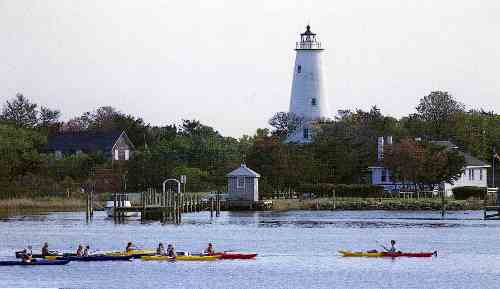
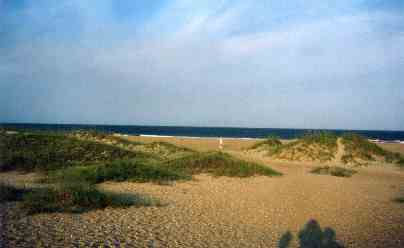
| Route 66 | Cities | Beaches |
 |
 |
|
| Ocracoke : The Other Island |
If you're looking for a first ocean vacation, or if you've done Myrtle Beach, the Gulf Coast and the Florida beaches and want something a little different, we have the answer : two weeks on Hatteras Island. A Hatteras trip will totally redefine what going to the beach means. For Hatteras and its sister island Ocracoke are an Ocean Wilderness with just a thin veneer of civilization. You won't be strolling any boardwalks or riding any rollercoasters here. You can, however, ride horses in the surf, hike through the largest Maritime Forest on the Atlantic Coast, walk up the tallest lighthouse in North America, learn to surf at the greatest surfing location east of California, learn to windsurf in the greatest windsurfing location in North America, and fish in the greatest fishing waters in the Continental United States. |
|
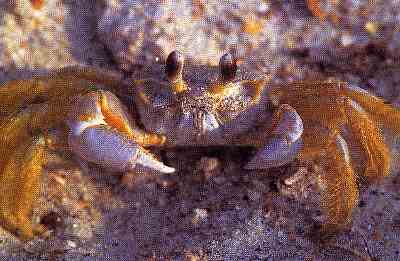 |
You should come to Hatteras Island for the greatest natural beaches on the East Coast. There are no grooming machines sifting and sweeping and raking sand all night. There's no beach replenishment, so the sand comes and goes with the winds and tides. There are no boardwalks, high rise hotels, concession stands or umbrella rental stands cluttering up the landscape. This is a national park, and while the park service has allowed small villages to serve the visitors, 90% of the outer banks is off limits to construction of any sort. Sandcrabs, molecrabs, coquinas, manta rays, pelicans, porpoises and other creatures will be your companions each day, and horseshoe crabs and sea turtles will come ashore at night to lay their eggs in the dunes. Driftwood, seashells, kelp, netting (sometimes with portugese glass balls still tied on), seagrass and other debris wash in with the tides. So you're going to experience the same beaches the first white men saw when they stepped ashore in the 1600s. |
| And your view of them won't be blocked by crowds. You can easily find unoccupied beaches. Some of the most heavily used will have 100 or so people on them at any one time. Notice Lighthouse Beach on the right, seen from atop the walkway around the rotating beacon. It's midafternoon the week of July Fourth, and the beach is noticeably uncongested. If you wanted to be totally alone, you could simply walk on down the beach a quarter of a mile and roll out your blanket. Also notice the famous Cape over an hour's walk in the distance,and the dense scrub forest pressing the dunes from the right (West). The Cape Point Campground is along the far dunes, to the right of the Cape along the South facing shoreline. If you camped there, you could swim every day either at this beach, on the so called Front Side, or west of the Cape, on the so called South Side. So you should come to Hatteras for the isolation. Your primary approach is to drive to Cedar Island or Swan Quarter, take the three hour ferries across Pamlico Sound to the village of Ocracoke, drive 14 miles across Ocracoke Island (on its only road), and take the hour ferry across to Hatteras Island. This ferry hopping far from four lane highways discourages most tourists. So does the lack of hotels, nightclubs, and malls. The only people vacationing here are those interested in beaches, fishing, or the various outdoor activities. |
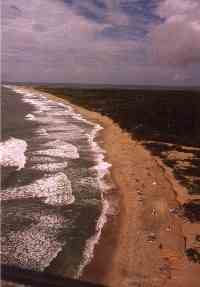 |
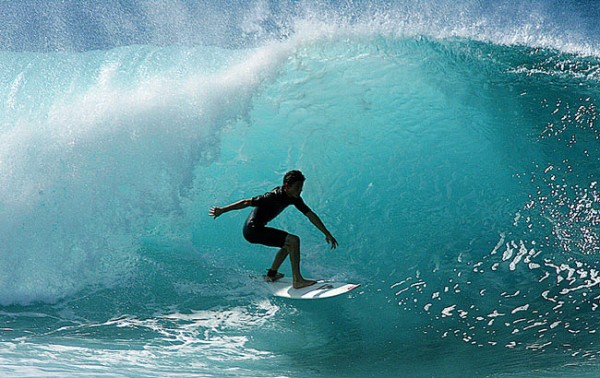 |
You should come to Hatteras for the surfing. All kinds of it. There's the board surfing of Hollywood movies, although the boards are shorter and lighter these days. There's also windsurfing, bodyboarding, and kiteboarding. Hatteras is the best place along the Atlantic Coast for any of these. You'll see vans full of surfers and surf equipment arriving from all over the country.
|
| You should come to Hatteras for the hiking. Beach hiking is a unique experience. You do it barefoot, and after two weeks your feet toughen for the hiking you'll do back home. Whenever you get hot you step into the water and cool off. You carry a bag on your belt and collect seashells along the way. You may see wild horses or whales. At first mention, you might think hiking down a beach for five hours would be incredibly boring since nothing ever changes. But that's not true. Every hundred yards or so everything is different : the sand texture, the size of the dunes, the slope or width of the beach, indentations, spits, offshore bars, or the kind of seashells at your feet. It's unique, and nowhere on either coast matches this 84 mile stretch of it. | 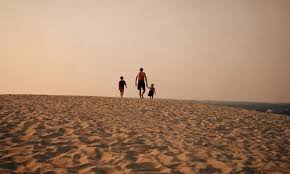 |
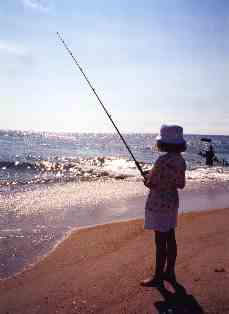 |
You should come to Hatteras for the Fishing. Out here, fishing is a whole different experience. You can rent equipment, hire guides and learn how to surf fish, pier fish, use light rigging inshore and heavy rigging offshore. We've caught a dozen different kinds of fish, and gone clamming and crabbing in Pamlico Sound. We've eaten seafood three meals a day for two weeks (ever have fish and eggs?). We've bounced lines off the bottom and fought marlin bigger than we were out in the Gulf Stream. When the Blues are running, you can pull fish in as fast as you can bait your hooks right off the piers at Avon and Rodanthe. |
| You should come to Hatteras for the kayaking. Back home we take canoes, rafts and kayaks down rivers or across lakes, but nothing compares to paddling a sea kayak out of sight of land on the glassy smooth Pamlico Sound, where the water is only three feet deep for 20 miles. And there is another form of paddling here: surfyaking. Unlike the long, streamlined sea kayak, surfyaking requires a short, highly maneuverable boat which can ride the front edge of a big wave. Sea kayaking is very relaxing, a sort of commune with Nature. Surfyaking is a violent adrenaline rush which punishes mistakes by hurling paddler and boat up on the beach, often upside down and backward. Equipment for both can be rented on Hatteras and lessons are available. Shown here is a guided twilight tour of the Pea Island Wildlife Refuge, one of the most popular paddling trips. | 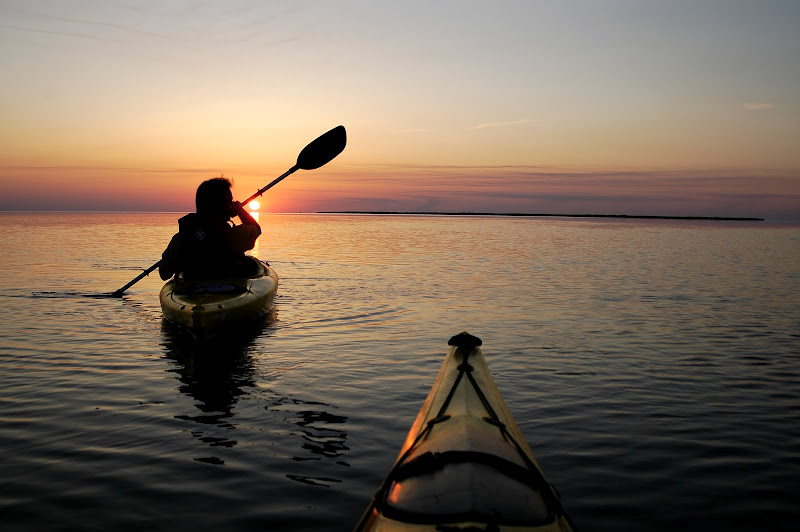 |
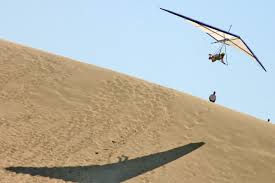 |
You should come to Hatteras for the hang gliding. Here at Jockey Ridge, you launch off the dunes and glide down along the gentle slope of sand. If anything goes wrong, you just stick your feet down and run to a stop and even if you have a crunch landing, you're not that far off the sand anyway. Here, hang gliding is a family sport. Middle school students and their parents can all learn with two or three lessons. |
You should come to Hatteras for the history. There's more of it out here than you have time for in just two weeks. There were the Native Americans who called the island Croatan. The Lost Colony up at Roanoke Island is still a historical mystery. Blackbeard and various other Pirates hid out here and were eventually caught here. Portsmouth was once the biggest town and most important port on the Carolina Coast. There was Civil War maneuvering here. The Monitor, the first submarine, was sunk out on Diamond Shoals. Another hundred ships, many famous, went down along this coast, and some of the ruins are still visible. The Wright Brothers created the airplane up at Kitty Hawk. Admiral Jimmy Doolittle made the first naval bombing raid from Hatteras Island. During World War II, German submarines lurked along this coast and sometimes sent English speaking crew members ashore to buy groceries. The U.S. Navy did most of its porpoise research at its Hatteras base. The famous lighthouse at Cape Hatteras is the largest ever built in North America. British sailors are buried in a special cemetery on Ocracoke. Shown here is the HMS Queen Elizabeth II, which is anchored at Roanoke Island for tours and takes short trips so passengers can experience life aboard a 1600 sailing ship. |
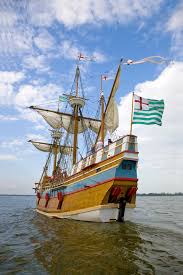 |
|
|||
|